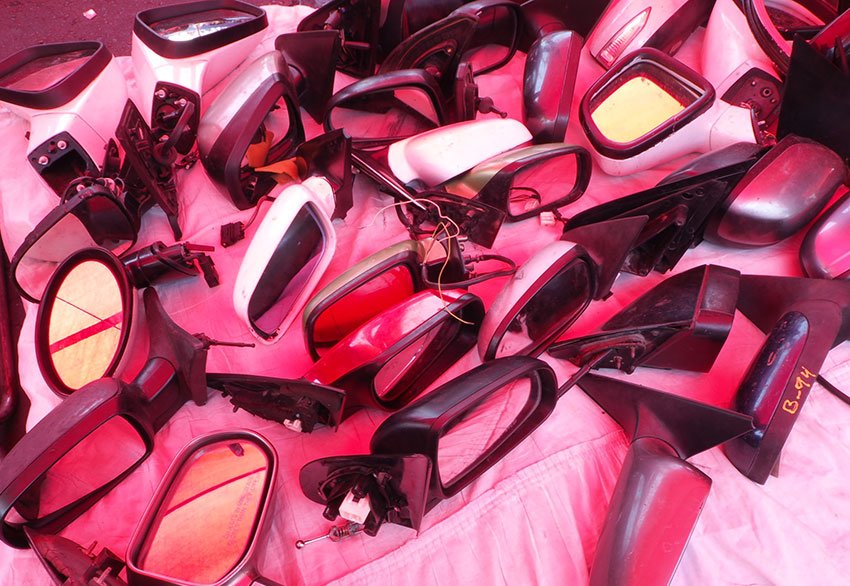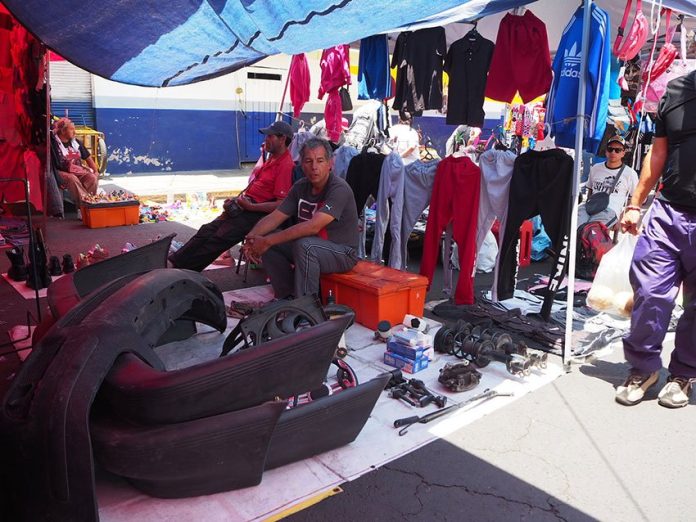Ropa de paca – clothing in bundles, huge plastic bales dumped out on to folding tables or tarps spread out on the ground for visitors to dig through.
Massive piles of mostly T-shirts that run for blocks through the tarp-covered streets of the Tianguis de la San Felipe de Jesús.
Almost all the clothes appear to be from the United States and arrive by the truckload, sold to the vendors in the hundreds of kilos.
Take a tour of the churches, baseball fields and community centers of Pittsburgh or Orlando, the T-shirts discarded memories of “The Hall Family Reunion” or “Christian Meetup 2013” at 30 pesos a pop.
“Barato! Barato!” the vendors holler: dresses and blouses for 50 pesos, pants for 40 or an armful of T-shirts for a couple of hundred.

There are estimated to be 40,000 vendors at “SanFe” every Sunday and hundreds of thousands of visitors. There aren’t any reliable international statistics, but this tianguis is said to be the largest street market in Latin America, and if that’s the case, it’s hard to imagine anything in the U.S. or Canada actually being larger.
The saying goes, “In SanFe you can find everything from a pin to a piece of the Titanic.” And that may very well be true, but it could take a number of visits, as you’re not likely to cover the entire seven kilometers of tent rows in a single day.
The San Felipe street market runs through four Mexico City colonias – San Felipe de Jesús, Esmeralda, Providencia and 25 de Julio – right on the edge of Nezahualcóyotl and Ecatepec in the state of Mexico, with the main passage along Villa de Ayala from Estado de Zacatecas to Avenida Gran Canal, where it splinters off on to side streets.
What began decades ago as locals selling odds and ends among rural cornfields and lagoons, along what was once a major river – the Gran Canal, has turned into a massive marketplace of car parts, used clothing, housewares, refrigerators, furniture and antiques.
As small rural towns became huge arms of the city, SanFe made a name for itself as a place to buy used tools. As the tianguis overtook the streets, the municipality tried to move the sellers indoors in the 60s, building the Mercado 25 de Julio to specialize in tools and hardware.
While some sellers joined in for the indoor sales, many remained on the streets and the street market just kept growing into the monstrosity it has become today.

Knock-off shoes, counterfeit concert T-shirts that were overproduced, genuine human hair and kilometers of rusty bolts and wrenches – you can find it all at SanFe. Some vendors are hyper-specialized down to car rearview mirrors or used bike tires, and the origin of much of the product is not necessarily on the up and up, but there’s an impressive amount to see.
And, well, a piece of the Titanic could certainly be considered “found” rather than “stolen.”
• Tianguis de la San Felipe de Jesús runs every Sunday from 8:00am to 6:00pm along Avenida Villa de Ayala from Calle Estado de Zacatecas in Colonia Providencia to Avenida Gran Canal in Colonia San Felipe de Jesús, then north to Mercado 25 de Julio.
This is the 14th in a series on the bazaars, flea markets and markets of Mexico City:
- How to find your way through the massive Mercado de la Merced
- From knick-knacks to treasure maps at Portales Antiques Flea Market
- Mercado Martínez de la Torre one of the best food markets in Mexico City
- Choose your adventure of history, gastronomy or art at Saturday Bazaar
- Collected artistic traditions of Mexico are under one roof at this city market
- Sharpen your bargaining skills at the best little antiques market
- Mexico City’s most colorful market is Mercado Jamaica, the flower market
- You’ll find art at Mercado Coyoacán, but the main attraction is food
- MercadoRoma, a Mexican public market reimagined for the 21st century
- Tuesdays in Taxqueña, the flea market of musical brotherhood
- Escandón Market is quintessential middle-class CDMX neighborhood market
- A walk through the Mexico City markets of Colonia La Condesa
- The San Juan market, Mexico City’s epicenter for culinary inquisition
